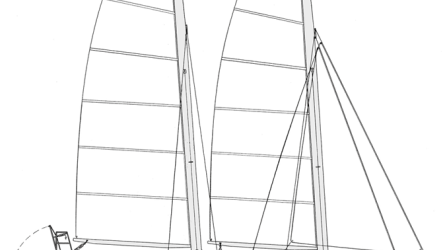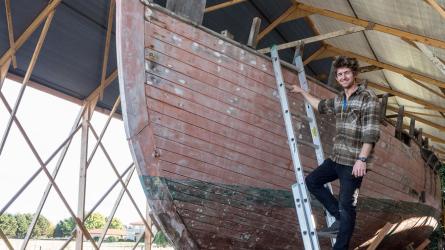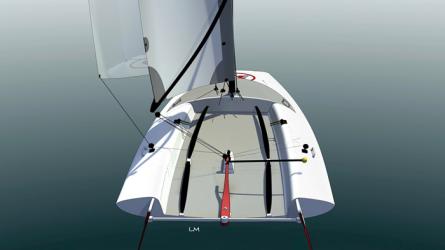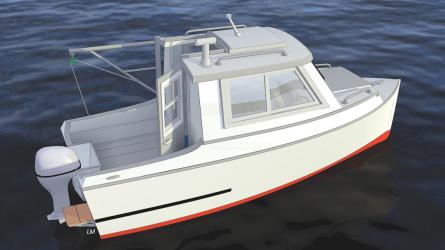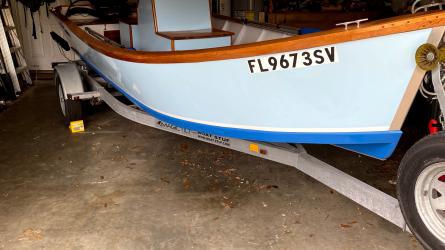A “New” Method for Hollow Wooden Mast Construction
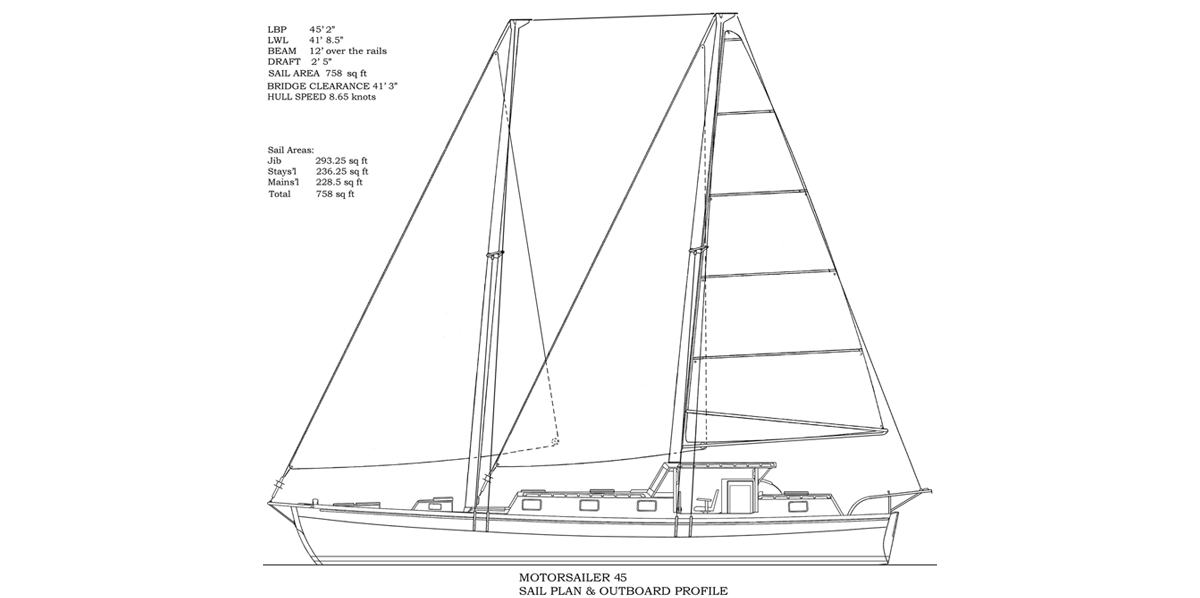
I have developed a “new” mast construction method for use on light- to moderate-displacement sailboats having a Marconi rig, and for motorsailers. I put “new” in quotes because I am sure it has been thought of before now.
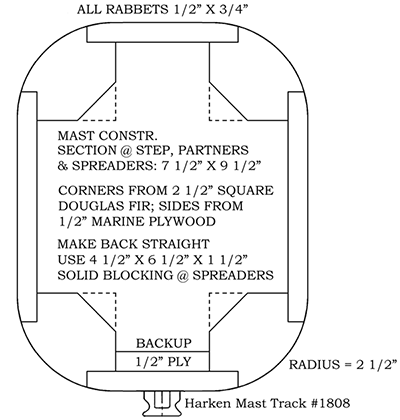
Mast Section from step to spreaders, 9 1/2″ x 7 1/2″ outside dimensions.
The four corners of the new construction sequence are all made identical in section, from Douglas fir or Sitka spruce 3″ x 3″ lumber. The corner pieces are rounded to a 2 1/2″ diameter radius, the inner corner is cut to a 45-degree bevel (to lighten the mast), and 1/2″ x 3/4″ rabbets are cut onto two corners to receive 1/2″ marine plywood front, back and sides. The corners are epoxy scarfed (8:1) full-height. They are identical in every location, greatly simplifying construction, as all corners are cut using a table saw set to the same settings. All mast taper is made on the plywood sides, back and front.
Construction uses epoxy glue and monel or stainless steel fasteners (staples, nails or screws) 6″ on center. With proper clamping, fasteners may be eliminated altogether.
The mast section is uniform from step to spreaders (as shown above). Above the spreaders, mast section tapers parabolically to 5 1/2″ x 7 1/2″. If so desired, for further weight-savings aloft, the inside corners may be cut deeper, removing more material. Doing so will weaken the mast only very slightly.
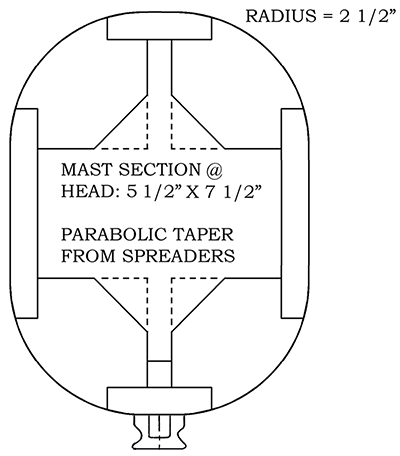
Mast Section at Head is 5 1/2″ x 7 1/2″—taper is parabolic above spreaders.
All fore & aft mast taper is on the front only—the back of the mast is perfectly straight for its entire height unless built-in “pre-curve” is desired. [The purpose of pre-curve is to automatically flatten the sail chord for windward work as the sail is sheeted in.] A 1/2″ plywood backup block is installed inside the mast back to receive fasteners for the #1808 Harken track shown.
Plywood panels from step to spreaders are ripped on the table saw to uniform dimensions. Panels above the spreaders are ripped for parabolic taper (back edge straight for the sides). Front and back panels above the spreaders are ripped along both edges for taper. Plywood panels are scarfed 8::1. If desired, for greater durability, the mast may be wrapped in 4 oz Xynole-polyester fabric saturated with epoxy, with the seam located under the mast track (this will add weight). The inside of the mast is epoxy sealed. Wires (including lightning ground) are pulled in PVC pipe attached to a side panel prior to lay-up.
Note that in my drawings, the edges of the plywood are affected by the radii of the mast corners. When finishing shaping, the outer laminate will be abraded along the edges. Masts finished in this fashion will definitely require fabric/epoxy covering. You can avoid this by making the radius 2″ instead of 2 ½″, at the expense of a more “square” looking spar section.
For the nut-cases (I have been one) who insist on having varnished spars—make the corners (use the 2″ radius) and plywood from the same species wood; epoxy seal and apply 12 coats of varnish that has a good UV filter—I recommend using Douglas fir for the species. I generally prefer using epoxy primers covered with linear polyurethane topcoats—very durable—and almost no maintenance.
The Harken #1808 track shown uses “Battcars” designed to receive the forward ends of solid fiberglass full-length battens. The only sail cars necessary are one for each batten, and reef points are located immediately below each of the lowest three battens. This simplifies sail construction and cost, and simplifies reefing, especially when used in concert with my Basket Boom, which contains the reefed portion of the sail. Said boom (my wishbone-style Basket Boom), also uses Battcars located at the base of the track (see Boom Detail drawing below).
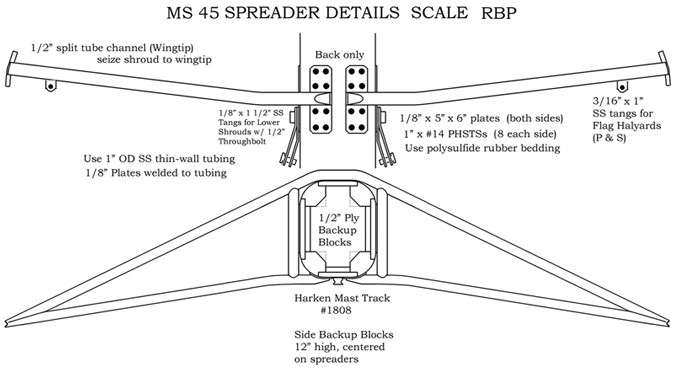
Spreader details.
Spreaders are made from polished 1″ stainless steel thin-wall tubing (or 3/4″ aluminum pipe) welded to 1/8″ stainless steel side and back plates. The plates are attached to the mast with 1″ x #14 flat head self-tapping screws, and are bedded with polysulfide rubber. Spreader lift angle should bisect the angle the upper shrouds make at the wingtips.
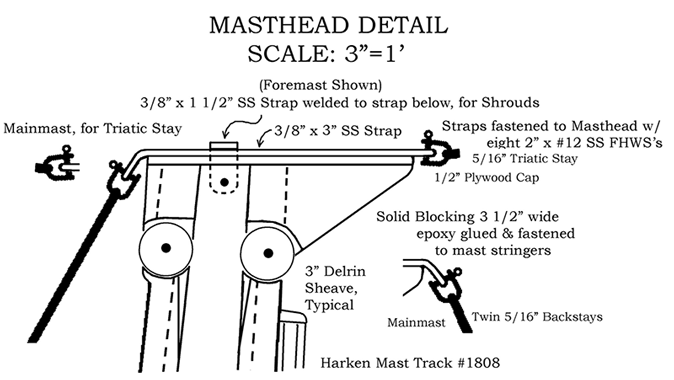
Detail of a masthead—the SS top plate is configured fore & aft for application (shown is the foremast for a schooner with equal height masts).
The masthead is made by adding solid wood sections fore & aft with a 1/2″ plywood cap to support two stainless steel straps, drilled and bent at their ends to receive shackles for stays and shrouds. Delrin sheaves (3″ Schaefer) are used for internal halyards as shown above. Sheave pins are 7/16″ SS. Dimensions shown are for masts on a 45’ motorsailer using 5/16″ shrouds, triatic stay and twin backstays, and 3/8″ forestay and main stay.
The mast construction, as drawn, is much stronger than necessary for the specific application intended (Motorsailer 45), and the solid corners could be made from 2x4s (as described below), in lieu of the 3x3s shown. This would save materials costs, and to a lesser extent, labor. I would stress, however, that air-dried wood is much preferable to kiln-dried wood for durability and rot-resistance. If using kiln-dried wood, I would be very thorough in epoxy sealing the mast interior, and I would cover the finished mast with Xynole-polyester fabric and epoxy. As always, great care should be taken with bedding compounds (these days I mostly use Bostik #920, above and below the waterline).
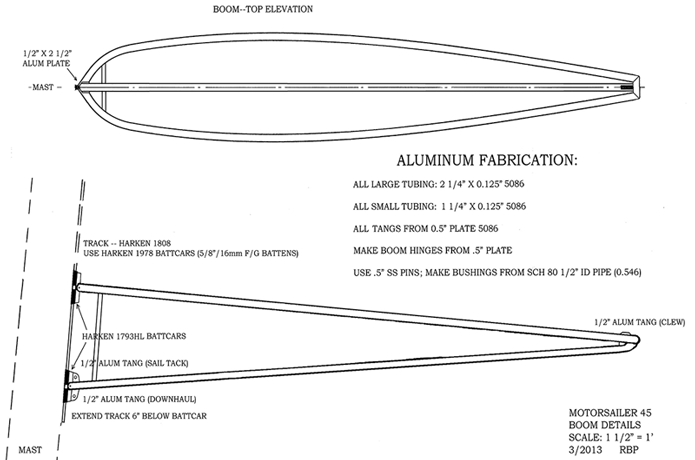
Basket Boom details.
I developed a new type of boom several years ago to utilize the Harken track. The upper portion is a “wishbone” boom, which clears both sides of the sail. The lower portion eliminates the need for a vang. When the sail is dropped, it falls inside the “basket”, which may have lacing on each side (not shown) to contain the sail and battens. A sail cover may be placed inside the basket boom with a top covering panel secured by Velcro. The boom could alternately be fabricated from polished stainless steel, using 1-1/2″ thin-wall tubing.
The basket boom uses two Harken Battcars at each attachment point (upper & lower), and should incorporate a downhaul to increase luff tension. In adapting this boom to other vessels, note that the wishbone must be designed to contact the after shroud (when reaching or running) before it touches the mast to prevent damaging the track and fasteners.
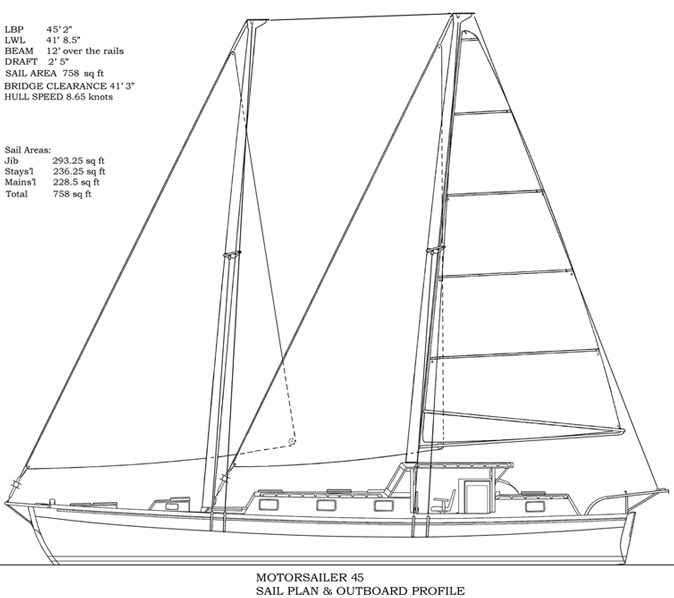
The new mast construction is intended for the Motorsailer 45 shown above, but may be employed on any light- to moderate-displacement vessel in this size range using the Marconi rig and single (or double) spreaders.
The new masts may be tabernacled, deck-stepped (over compression posts), or keel stepped. The overall weight of these masts will be as light or lighter than that for aluminum masts of equivalent strength.
For lighter loads or for even lighter-weight masts, corners may be made from 2x4s (on the flat at 45 degrees); and sides, front and back may be made from 3/8″ 5-ply marine plywood (such as Shelman or Joubert). Smaller masts and spars can use the same construction, with scantlings down-sized appropriately. Fabric/epoxy covering will prolong mast life, but is not particularly necessary structurally. All fasteners penetrating the finished mast should be either sleeved (bolts for shroud attachment) or carefully bedded using flexible, UV-resistant compound.
I know carbon-fiber masts are all the rage now, but I still firmly believe that well-designed and –made wood/epoxy masts are the overall best in terms of light-weight, strength, durability and low cost. A mast made using the above method will cost a fraction of an equivalent mast in carbon fiber or aluminum, and it will be more durable. As I keep telling people, aluminum is good for beer cans!
4/2/2014 St. Lucie Village, FL
